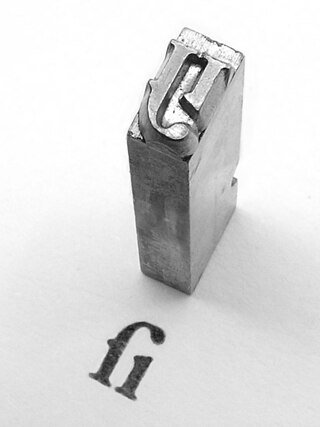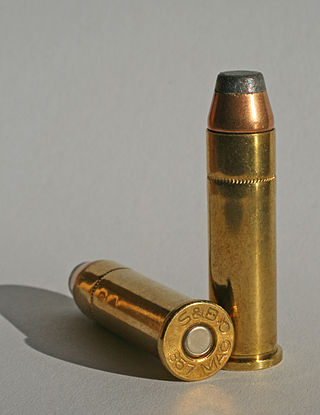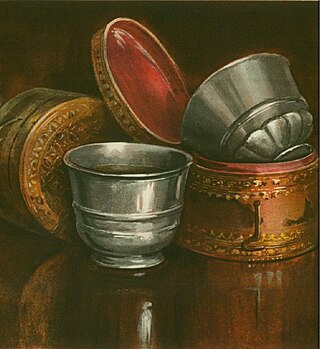Related Research Articles

Antimony is a chemical element; it has symbol Sb (from Latin stibium) and atomic number 51. A lustrous gray metalloid, it is found in nature mainly as the sulfide mineral stibnite (Sb2S3). Antimony compounds have been known since ancient times and were powdered for use as medicine and cosmetics, often known by the Arabic name kohl. The earliest known description of the metalloid in the West was written in 1540 by Vannoccio Biringuccio.

A metal is a material that, when freshly prepared, polished, or fractured, shows a lustrous appearance, and conducts electricity and heat relatively well. Metals are typically ductile and malleable. These properties are the result of the metallic bond between the atoms or molecules of the metal.

Bloodletting is the withdrawal of blood from a patient to prevent or cure illness and disease. Bloodletting, whether by a physician or by leeches, was based on an ancient system of medicine in which blood and other bodily fluids were regarded as "humours" that had to remain in proper balance to maintain health. It is claimed to have been the most common medical practice performed by surgeons from antiquity until the late 19th century, a span of over 2,000 years. In Europe, the practice continued to be relatively common until the end of the 19th century. The practice has now been abandoned by modern-style medicine for all except a few very specific medical conditions. In the beginning of the 19th century, studies had begun to show the harmful effects of bloodletting.

A tablet is a pharmaceutical oral dosage form or solid unit dosage form. Tablets may be defined as the solid unit dosage form of medication with suitable excipients. It comprises a mixture of active substances and excipients, usually in powder form, that are pressed or compacted into a solid dose. The main advantages of tablets are that they ensure a consistent dose of medicine that is easy to consume.

A cartridge, also known as a round, is a type of pre-assembled firearm ammunition packaging a projectile, a propellant substance and an ignition device (primer) within a metallic, paper, or plastic case that is precisely made to fit within the barrel chamber of a breechloading gun, for convenient transportation and handling during shooting. Although in popular usage the term "bullet" is often used to refer to a complete cartridge, the correct usage only refers to the projectile.
A metalloid is a type of chemical element which has a preponderance of properties in between, or that are a mixture of, those of metals and nonmetals. There is no standard definition of a metalloid and no complete agreement on which elements are metalloids. Despite the lack of specificity, the term remains in use in the literature of chemistry.

In printing, type metal refers to the metal alloys used in traditional typefounding and hot metal typesetting. Historically, type metal was an alloy of lead, tin and antimony in different proportions depending on the application, be it individual character mechanical casting for hand setting, mechanical line casting or individual character mechanical typesetting and stereo plate casting. The proportions used are in the range: lead 50‒86%, antimony 11‒30% and tin 3‒20%. Antimony and tin are added to lead for durability while reducing the difference between the coefficients of expansion of the matrix and the alloy. Apart from durability, the general requirements for type-metal are that it should produce a true and sharp cast, and retain correct dimensions and form after cooling down. It should also be easy to cast, at reasonable low melting temperature, iron should not dissolve in the molten metal, and mould and nozzles should stay clean and easy to maintain. Today, Monotype machines can utilize a wide range of different alloys. Mechanical linecasting equipment uses alloys that are close to eutectic.

A pnictogen is any of the chemical elements in group 15 of the periodic table. Group 15 is also known as the nitrogen group or nitrogen family. Group 15 consists of the elements nitrogen (N), phosphorus (P), arsenic (As), antimony (Sb), bismuth (Bi), and moscovium (Mc).

A center-fire is a type of metallic cartridge used in firearms, where the primer is located at the center of the base of its casing. Unlike rimfire cartridges, the centerfire primer is typically a separate component seated into a recessed cavity in the case head and is replaceable by reloading the cartridge.

Britannia metal is a specific type of pewter alloy, favoured for its silvery appearance and smooth surface. The composition by weight is typically about 92% tin, 6% antimony, and 2% copper.
In literary and historical analysis, presentism is a term for the introduction of present-day ideas and perspectives into depictions or interpretations of the past. Some modern historians seek to avoid presentism in their work because they consider it a form of cultural bias, and believe it creates a distorted understanding of their subject matter. The practice of presentism is regarded by some as a common fallacy when writing about the past.

An antimonial cup was a small half-pint mug or cup cast in antimony popular in Europe during the 17th and 18th centuries. They were also known under the names "pocula emetica," "calices vomitorii," or "emetic cups", as wine that was kept in one for a 24‑hour period gained an emetic or laxative quality. The tartaric acid in the wine acted upon the metal cup and formed tartarised antimony.
Antimonials, in pre-modern medicine, were remedies principally containing antimony, used chiefly for emetic purposes. They might also have qualified for cathartic, diaphoretic, or simply alternative uses. Such treatments were considered unparalleled in their strength.
This is a glossary of jargon related to peer-to-peer file sharing via the BitTorrent protocol.

William McKinley, the 25th president of the United States, was shot on the grounds of the Pan-American Exposition in the Temple of Music in Buffalo, New York, on September 6, 1901, six months into his second term. He was shaking hands with the public when an anarchist, Leon Czolgosz, shot him twice in the abdomen. McKinley died on September 14 of gangrene caused by the wounds. He was the third American president to be assassinated, following Abraham Lincoln in 1865 and James A. Garfield in 1881.

Thin is a 2006 cinéma vérité documentary film directed by Lauren Greenfield and distributed by HBO. It was filmed at The Renfrew Center of Florida in Coconut Creek, a 40-bed residential facility for the treatment of women with eating disorders. The center has been described as "one of the nation's best-known inpatient eating disorders centres". The film follows four women with anorexia nervosa, bulimia nervosa and other eating disorders in their struggle for recovery. The film premiered at the 2005 Sundance Film Festival in 2005, before premiering to the general public on November 14, 2006 on HBO.

Benjamin Brandreth was a pioneer in the early use of mass advertising to build consumer awareness of his product, a purgative that allegedly cured many ills by purging toxins out of the blood. He became a successful and wealthy businessman, bank president, and New York State Senator.

A cast bullet is made by allowing molten metal to solidify in a mold. Most cast bullets are made of lead alloyed with tin and antimony; but zinc alloys have been used when lead is scarce, and may be used again in response to concerns about lead toxicity. Most commercial bullet manufacturers use swaging in preference to casting, but bullet casting remains popular with handloaders.
William Lee Bergstrom, commonly known as The Suitcase Man or Phantom Gambler, was a gambler and high roller known for placing the largest bet in casino gambling history at the time, amounting to $777,000 at the Horseshoe Casino, which he won. Bergstrom returned to the Horseshoe three years later in 1984 and placed several additional bets, including a $1 million bet which he lost.
"A Bitter Pill to Swallow" is the ninth episode of the second season and 31st episode overall from the FOX series Gotham. The episode was written by Megan Mostyn-Brown and directed by Louis Shaw-Milito. It was first broadcast in November 16, 2015 in FOX. In this episode, Tabitha sends a group of hitmen to kill Gordon after Galavan's arrest. Gordon and Barnes investigate Galavan's penthouse for clues until they're ambushed by Tabitha's hitmen.
References
- ↑ McCallum, RI (1977). "President's address. Observations upon antimony". Proceedings of the Royal Society of Medicine. 70 (11): 756–63. doi:10.1177/003591577707001103. PMC 1543508 . PMID 341167.
- ↑ "Antimony: a metallic cleanse of the Middle Ages". Office for Science and Society. Retrieved 6 May 2024.
- ↑ Robinson, William Josephus. The Medical critic and guide, Volumes 8-10.